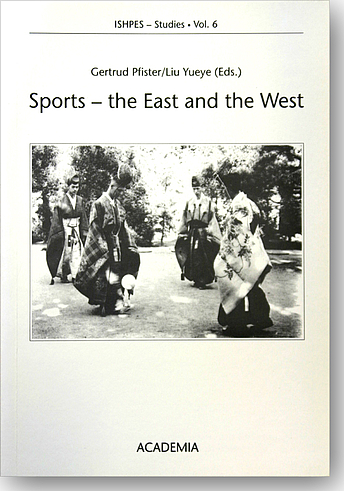Pfister | Yueye
Sports - the East and the West
ISBN 978-3-89665-034-4
englischEast meets West - the meeting between East and West is overdue in many areas, especially in the area of sport history. The ISHPES Seminar was the first systematic scientific exchange on the subject of interacting developments of Eastern and Western physical activities.
Different forms of body and movement cultures have developed in the East and the West - forms which demonstrate how physical activities, social and cultural conditionsm patterns of thinking and the way of being-in-the-world are mutually dependent on each other.
From a Western point of view the East was for centuries an empty space on the map - a world associated with phantasies and dreams. Since Marco Polo's voyage of discovery in the thirteenth century, for instance, few reports have come to Europe from China. To Pietro da Alfaro in 1580 travelling to China seemed equally as utopian as flying to the moon. Even today we know very little about the ancient cultures, religions and the colourful variety of physical activities in the East.
Western influence on South-East Asia grew in the 19th century. After the turn of the century sport of Anglo Saxon origin, a symbol of modernity, started to spread across Eastern countries. Sport began to displace and supplant traditional forms of physical culture. What at first seemed to be a one-way process - the universalisation of modern sport - is increasingly turning out to be a complex interweaving of influences. In recent decades the fasciantion of 'the other' and the exotic has been growing in the West and there has been an extraordinary boom in the Eastern religions, body practices and forms of movement. In Germany, for example, sports centres that have sprung up on nearly every 'street corner' include Tai Chi, Qi Gong, yoga or karate in their programmes.
Both these processes, the process of sportificationwith its demand for universalisation and the growing importance of Eastern practices in the West, need a historical approach as well as scientific analysis. It is important on the one hand to fight the westernization of the world and the accompanying loss of cultural identity, life style and mentalities. On the other hand one must ask whether the adoption of Eastern body and movement practices in the West makes sense or whether it encourages the trend towards global uniformity.
This volume will contribute towards uncovering the manifold links between the past and the present, and towards bringing traditions back to mind, not least in order to strengthen cultural identities.
East meets West - die Begegnung zwischen West und Ost ist auf vielen Gebieten, vor allem auch im Bereich der Sportgeschichte, schon lange überfällig. Im Westen und im Osten haben sich verschiedene Formen der Bewegungskultur entwickelt, an denen sich die gegenseitigen Abhängigkeiten von Bewegungsaktivitäten, sozialen/kulturellen Bedingungen sowie Denk- und Deutungsmustern ablesen lassen.
Aus westlicher Perspektive war Asien lange Zeit ein weißer Fleck auf der Landkarte, eine Welt, um die sich Phantasie und Träume rankten. Nur spärlich drangen beispielsweise die Nachrichten seit der Reise Marco Polos aus dem Reich der Mitte nach Europa. Auch heute wissen wir immer noch viel zu wenig über die uralten Kulturen, die fremden Religionen und die bunte Vielfalt von Bewegungsaktivitäten im fernen Osten.
Der westliche Einfluß auf Südostasien verstärkte sich im 19. Jahrhundert, und nach der Jahrhundertwende breitete sich der Sport nach angelsächsischem Vorbild, das Symbol für Modernität, auch in Südostasien aus. Er begann zunehmend, traditionelle Bewegungsformen zu verdrängen und zu überwuchern. Was zunächst als eine Einbahnstraße, ein Universalisierungsprozeß des Sports, erschien, erweist sich zunehmend als komplexer Wechselwirkungsprozeß. Seit einigen Jahrzehnten wächst im Westen die Faszination des Fremden und des Exotischen, östliche Religionen, Körperpraktiken und Bewegungsformen boomen. In Deutschland werden beispielsweise fast an 'jeder Straßenecke' Tai Chi, Qi Gong, Yoga oder auch Karate angeboten.
Beide Prozesse, die Versportlichung mit ihrem Universalisierungsanspruch und die wachsende Bedeutung östlicher Bewegungsformen im Westen, bedürfen einer historischen Aufarbeitung und einer wissenschaftlichen Analyse. Dabei muß es zum einen darum gehen, der Verwestlichung der Welt und dem damit verbundenen Verlust von kulturellen Identitäten, Lebensstilen und Mentalitäten entgegenzutreten. Zum anderen ist aber auch zu fragen, ob ein Transfer bewegungskultureller Praktiken vom Osten in den Westen sinnvoll ist oder ob er gerade die Universalisierungstendenzen verstärkt.
Der Band soll dazu beitragen, die vielfältigen Verflechtungen von Vergangenheit und Gegenwart aufzuschlüsseln und Traditionen in Erinnerung zu rufen, nicht zuletzt, um kulturelle Identitäten zu stärken.


